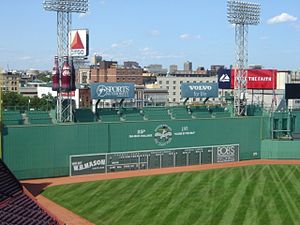
The warning track is the part of the baseball field that is closest to the wall or fence and is made of a different material than the field. Common materials for the warning track include dirt or rubber; it should always be of a different material than the playing field. The change of terrain serves as a "warning" for fielders trying to make a deep catch that they are running out of room, since it is often difficult for the fielder to keep his eye on a fly ball while keeping track of his position relative to the wall. It runs parallel to the ballpark's outfield wall. The track can also be utilized by vehicles on grass fields, thus preserving the playing field.
Despite the warning track's presence, it is common to see outfielders crash into the wall to make a catch, due to a desire to field the play regardless of the outcome, because they fail to register the warning in time, as they are looking up at the fly ball, or because they do not know how many steps they will have on the track.
The "track" part of the term comes from Old Yankee Stadium, where an actual running track was built for the use of track and field events. In 1949 Major League Baseball formally began requiring a warning track. There still are professional fields without a proper warning track, however, such as Tropicana Field, which uses brown-colored turf.
The width of warning tracks can vary by rules and level of play. In general it is designed to give fielders three steps of warning before the outfield wall. The warning tracks in Major League Parks are roughly 16 feet (5 m) wide, while the warning track in Olympic stadiums are roughly 20 feet (6 m) wide, and on softball fields are often 10 feet (3 m). When Major League Baseball instituted the warning track, it was 10 feet (3 m) wide.
References
- ^ "Baseball Field Maintenance: A General Guide for Fields of All Levels" (PDF). Major League Baseball & Major League Baseball Players Association. Retrieved 2019-08-29.
- "Warning Track Definition - Sporting Charts". www.sportingcharts.com. Retrieved 2019-08-29.
- Zwaska, Paul (2019-07-26). "The Danger of Artificial Turf Warning Tracks | Beacon Athletics". Beacon Athletics Blog & Ballfield Tips. Retrieved 2019-08-29.
- ^ Glanville, Doug (2012-08-29). "The warning track is useless". ESPN.com. Retrieved 2019-08-29.
- "This Day in Baseball History: July 12th, 1949". Way Back and Gone. 2009-07-12. Retrieved 2019-08-29.
- Beware of warning track at Tropicana Field: Cleveland Indians chatter. May 9, 2014; retrieved Aug. 6, 2014.
- "Building the Warning Track | Beacon Athletics". Beacon Athletics Blog & Ballfield Tips. Retrieved 2019-08-29.
- Kagan, David T. (1990-02-01). "The effects of coefficient of restitution variations on long fly balls". American Journal of Physics. 58 (2): 151–154. Bibcode:1990AmJPh..58..151K. doi:10.1119/1.16224. ISSN 0002-9505.